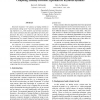Free Online Productivity Tools
i2Speak
i2Symbol
i2OCR
iTex2Img
iWeb2Print
iWeb2Shot
i2Type
iPdf2Split
iPdf2Merge
i2Bopomofo
i2Arabic
i2Style
i2Image
i2PDF
iLatex2Rtf
Sci2ools
DSN
2009
IEEE
2009
IEEE
Comparing anomaly-detection algorithms for keystroke dynamics
Keystroke dynamics—the analysis of typing rhythms to discriminate among users—has been proposed for detecting impostors (i.e., both insiders and external attackers). Since many anomaly-detection algorithms have been proposed for this task, it is natural to ask which are the top performers (e.g., to identify promising research directions). Unfortunately, we cannot conduct a sound comparison of detectors using the results in the literature because evaluation conditions are inconsistent across studies. Our objective is to collect a keystroke-dynamics data set, to develop a repeatable evaluation procedure, and to measure the performance of a range of detectors so that the results can be compared soundly. We collected data from 51 subjects typing 400 passwords each, and we implemented and evaluated 14 detectors from the keystrokedynamics and pattern-recognition literature. The three top-performing detectors achieve equal-error rates between 9.6% and 10.2%. The results—along with the ...
Computer Networks | Detectors | DSN 2009 | Keystroke Dynamics—the Analysis | Repeatable Evaluation Procedure |
| Added | 20 May 2010 |
| Updated | 20 May 2010 |
| Type | Conference |
| Year | 2009 |
| Where | DSN |
| Authors | Kevin S. Killourhy, Roy A. Maxion |
Comments (0)

